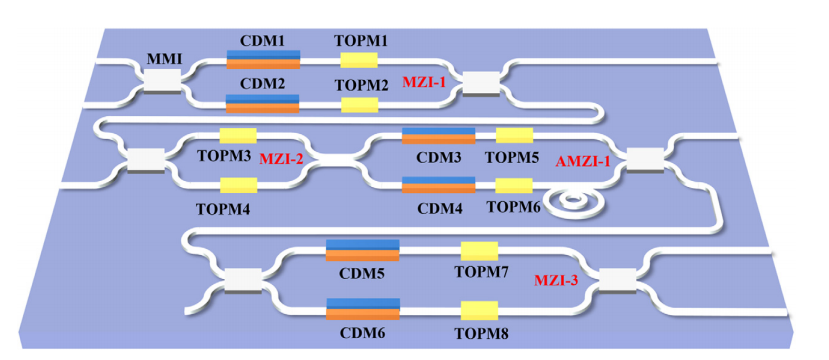
The article focuses on the development of a quantum key distribution (QKD) chip based on silicon-on-insulator (SOI) technology that employs a time-bin encoding scheme with decoy states. This system aims to enhance the performance of QKD by using integrated modulators to achieve high-speed and high-fidelity quantum state encoding.
Chip Design and Integration:
The QKD chip is designed using a combination of Thermo-optic Phase Modulators (TOPMs) and Carrier-Depletion Modulators (CDMs), allowing for high-speed modulation and precise quantum state preparation. This hybrid design ensures flexibility in adjusting quantum states' relative phase.
The chip supports the encoding and decoding of four BB84 quantum states at a repetition rate of 100 MHz, a crucial advancement for QKD systems aiming for high-speed, secure communication.
Modulator Performance:
Extinction ratio measurements were conducted for both types of modulators. The TOPM exhibited a high extinction ratio of 26.55 dB, while the CDM had a slightly higher extinction ratio of 32.01 dB, suitable for high-speed modulation.
The integration of both modulators within the chip ensures stable and efficient quantum state switching, addressing issues like the saturation in phase response seen in CDMs alone.
Time-bin and Phase-state Quantum Preparation:
Time-bin encoding uses temporal pulses, and the system demonstrated high visibility of quantum states, with the phase states |+i and |−i achieving visibility of 93.66% and 92.36%, respectively, confirming high-contrast interference.
The system also tested the time-bin states |0i and |1i, achieving 19.33 dB and 18.72 dB extinction ratios, respectively.
Stability Testing:
The stability of the quantum states was rigorously tested over a 2-hour period, showing consistent extinction ratios and phase stability for both time- and phase-based states. However, temperature fluctuations in the SOI material impacted phase stability, with a high thermo-optic coefficient of SOI being identified as a potential source of instability.
The proposed solution to this issue involves integrating Si3N4 for the delay line, as it has a much lower thermo-optic coefficient than SOI, significantly reducing temperature-induced phase shifts.
Quantum Key Distribution:
The test system used a picosecond pulse laser and erbium-doped fiber amplifier to prepare quantum states at Alice's side, which were then transmitted to Bob's side for decoding. The quantum states were decoded using a passive decoding scheme, with the output measured using InGaAs/InP-based single-photon detectors.
The QKD system demonstrated efficient key distribution over a 2-meter single-mode fiber link, with minimized signal loss, ensuring the integrity of the quantum states during transmission.
This work demonstrates a successful integration of SOI photonic technology for practical QKD systems. By addressing key challenges such as phase stability and high-speed modulation, the chip design offers significant improvements over previous systems. The introduction of Si3N4 waveguides in the design helps mitigate the effects of temperature fluctuations, enhancing long-term stability. The results from this study contribute to the practical implementation of secure, high-speed quantum key distribution, which could support the future development of quantum communication networks.
OMeda (Shanghai Omedasemi Co.,Ltd) was founded in 2021 by 3 doctors with more than 10 years of experience in nanpfabrication. It currently has 15 employees and has rich experience in nanofabrication (coating, lithography, etching, two-photon printing, bonding) and other processes. We support nanofabrication of 4/6/8-inch wafers.